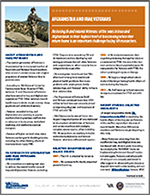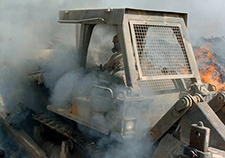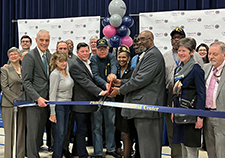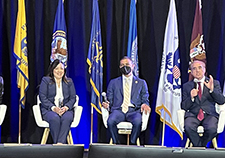Office of Research & Development |
 |
Finding new ways to restore ill and injured Veterans from our wars in Iraq and Afghanistan to their highest level of functioning and helping to create the best life possible for them when they return home are two of the most important challenges VA researchers face today.
This newest generation of Veterans is characterized by an increased number of Reservists and National Guard members who served in combat zones; a higher proportion of women; and different patterns of injuries, such as multiple injuries from explosions, than were seen among Veterans of previous wars.
Afghanistan and Iraq combat Veterans can receive cost-free medical care for any condition related to their service in the theater of war for five years after the date of their discharge or release. They may also be eligible for one-time dental services, but must apply for those services within 180 days of their separation date from active duty.
In addition, VA Vet Centers throughout the nation provide a broad range of counseling, outreach, and referral services to Afghanistan and Iraq combat Veterans, and to Veterans of all America's wars. Vet Centers guide Veterans and their families through many of the major lifestyle adjustments that often take place when a Veteran returns from combat.
America's Veterans make great sacrifices for our nation. These sacrifices often include temporary or permanent changes to their physical and mental health status. VA has a comprehensive research agenda to address the deployment-related health issues of Veterans who have returned from the wars in Afghanistan and Iraq. Some key topics are outlined below.
More detail on VA research involving Iraq and Afghanistan Veterans can be found on several of our other topic Web pages, including mental health, PTSD, prosthetics, spinal cord injury, suicide prevention, and TBI.
Veterans Metrics Initiative—VA is among several public and private partners working with the Henry M. Jackson Foundation for the Advancement of Military Medicine on a new study aimed at learning what types of programs and services are most helpful to Veterans as they reintegrate after deployment.
The Veterans Metrics Initiative will enroll 7,500 service members separating from the Army, Navy, Marine Corps, Air Force, and Reserve and National Guard units. Researchers will survey these men and women within 90 days prior to their leaving military service and reassess them every six months for three years.
The study will document Veterans' well being during their transition from service in the areas of physical and emotional health, work, finances, and social relationships. It will also identify the transition and reintegration programs Veterans use and will study the component parts of those programs. Finally, it will study the link between these program components and Veterans' well being.
Researchers hope the study will provide a better understanding of what happens to Veterans as they leave the military, and the services that are most effective and meaningful for them at different stages of their transition.
Military personnel face challenges during their tours of duty that can make it difficult to readjust to life back home. Many service members may need mental health care after returning from duty in Afghanistan or Iraq. Service members may experience symptoms of psychological distress, such as PTSD. Other issues may include stress, mood, anxiety, sleep, psychotic, and addictive disorders.
VA Cooperative Study #566 is examining the health effects of the Iraq war on participants, especially those effects involving mental health. More than 800 service members and Veterans are participating in this study. The researchers hope to learn more about the longer-lasting effects of war on mood and stress symptoms, thinking and reaction skills, and different aspects of daily life, such as work and social activities.
Non-suicidal self-injury—A 2015 study led by researchers at the Durham VA Medical Center found that non-suicidal self injury (purposely hurting oneself without conscious suicidal intent) is relatively common among Iraq and Afghanistan Veterans. Of the 151 Veterans of the two wars studied by the research team, 14 percent reported a history of such injuries.
Veterans with schizophrenia or bipolar disorder were excluded from the group, but there was a higher-than average proportion of Veterans with PTSD. In the study group, 35 percent had PTSD, 21 percent had depression, and 8 percent had alcohol use disorder. More than 90 percent of the group was male and 67 percent was white.
The study also found that those who deliberately hurt themselves were more likely to engage in suicidal behavior. The researchers believe that these injuries could serve as a marker for identifying which Veterans are more likely to attempt suicide in the future.
Sexual dysfunction—In another 2015 study of 247 Veterans who had served in Iraq and Afghanistan, almost 18 percent screened positive for sexual functioning difficulties. The study was conducted at the post-deployment health clinic at the Michael E. DeBakey VA Medical Center in Houston.
The study found that other factors linked with self-reported sexual dysfunction included depression, PTSD, being female, and having a higher level of service-connected disability. The researchers could not determine whether military sexual trauma or minority sexual status were linked to sexual dysfunction.
VA has a continuing commitment to fund scientifically meritorious efforts to understand, prevent, and treat PTSD. VA research overwhelmingly focuses on potential treatment advances, especially those related to new drugs.
Cognitive processing therapy—In the 1980s, Patricia Resick, PhD, developed cognitive processing therapy (CPT), a 12-session cognitive behavioral treatment that can be administered to individuals or to groups, to help victims overcome symptoms of sexual trauma.
In 2006, a study led by Candice M. Monson, PhD, of the VA'sNational Center for PTSD found that the symptoms of Veterans with PTSD were significantly reduced in those who received CPT. CPT is now one of two of the most effective treatments used by VA clinicians for the illness; the other is prolonged exposure therapy.
VA and DoD consortia—In September 2012, VA and DoD announced that the two departments were combining more than $100 million to fund two new consortia aimed at improving diagnosis and treatment of PTSD and mild traumatic brain injury (mTBI).
These consortia are bringing together leading scientists and researchers, and are part of VA and DoD's response to President Obama's executive order to improve access to mental health services for Veterans, service members, and military families.
Timing of PTSD care—The symptoms of PTSD can be significantly improved in Veterans who receive prompt mental health care. A 2014 study led by researchers at the San Francisco VA Medical Center looked at nearly 40,000 Iraq and Afghanistan Veterans who received VA mental health care between 2001 and 2011 and had a post-deployment diagnosis of PTSD.
They found that Veterans who sought and received care soon after the end of their service had lower levels of PTSD upon follow-up a year after they initiated care. For each year that a Veteran waited to initiate treatment, there was about a 5 percent increase in the odds of their PTSD either not improving or worsening.
PTSD's relationship to Iraq war phase—A 2015 study of 738 Veterans by the National Center for PTSD found that guerilla tactics such as suicide attack and roadside bombs may trigger more posttraumatic stress than conventional warfare.
Researchers in the study identified three distinct phases of the Iraq war: the initial invasion phase, the insurgency phase, and the surge phase. They found that men, who made up about half of the overall group, were more than twice as likely to have a diagnosis of PTSD if they served during the insurgency phase, during which more guerilla-style tactics were used, compared with those who served in either of the other two phases.
This trend, however, was not seen among the women in the sample, who made up about half of the overall group.
Prevalence of PTSD—Another 2015 VA study looked at combined data and found that, on average, 23 percent of Iraq and Afghanistan Veterans have been diagnosed with PTSD.
The research team looked at 33 studies published between 2007 and 2013. Some of these studies included hundreds of thousands of Veterans, while others were conducted on a smaller scale.
The team said that their new results should be interpreted with caution, because of methodological differences among the existing studies and other limitations, including the fact that most studies included only Veterans enrolled in VA health care, which may skew their estimates upward.
Brain function in PTSD—Researchers at the Durham VA Medical Center and Duke University found in 2015 that regions of the brain function differently among people with PTSD, causing them to generalize non-threatening events as if they were the original trauma.
The team looked at 67 Veterans who had been deployed to conflict zones within Iraq and Afghanistan, and who had been involved in traumatic events. Thirty-two had been diagnosed with PTSD, and 35 did not have the disorder.
The findings suggest that exposure-based PTSD treatment strategies might be improved by focusing on cues that resemble the initial event, but are still distinct from it.
The study of neurotrauma is an important priority of VA researchers. Veterans wounded in Iraq and Afghanistan are surviving in greater numbers than in previous conflicts due to advances in body armor, battlefield medicine, and medical evacuation transport. As a result, more Veterans are living with disabling injuries, including the often-lifelong effects of TBI.
VA research has shown that the effects of TBI on Veterans often lead to long-term mental and physical health problems that cause problems with their employment, family relationships, and their ability to live in their communities.
Researchers have also shown that most Veterans with confirmed TBI have accompanying psychiatric illnesses, such as PTSD, depression, or anxiety. VA is working jointly with DoD, the Department of Health and Human Services, and the Department of Health and Human Services on an action plan to address the long-term issues of TBI that affect the psychological health and overall well-being of Veterans.
Current projects range from basic injury research through long-term health outcomes studies in Veterans. They include examining screening approaches to determine TBI; looking for biomarkers (measurable signs) to detect mild TBI; and using pictures from magnetic resonance imaging and diffusion tensor imaging to evaluate long-term structural and functional changes to the brain after TBI.
Researchers are also looking at drugs to block pathways that program cells to die, and medication to improve recovery of brain function after injuries occur.
Brain aging caused by bomb blasts—A 2015 study led by researchers from the Translational Research Center for TBI and Stress Disorders (TRACTS) at the VA Boston Healthcare System found that Veterans who were near to bomb blasts in Iraq and Afghanistan appear to experience faster brain aging.
The team studied 195 Veterans who had been exposed to bomb blasts within 100 feet and 56 who had not. Study participants had an average age of 33 years. By conducting specially designed brain imaging on each Veteran, the team learned that even in blasts that do not necessarily lead to concussion, Veterans exposed to bomb blasts showed aging in brain images designed to detect the "leakiness" and fraying of the white matter in the brain.
Consequences of this potentially premature brain aging could be increased rehabilitation time and an earlier need for health care for aging issues like dementia.
VA supports a wide array of research in engineering and technology to improve the lives of Veterans with disabilities. Several
Within the centers, research is being carried out on a number of cutting-edge technologies, including advanced wheelchair designs. VA is also looking at ways to regrow vital nerve connections and body tissues and to prevent limb loss.
VA researchers are also helping to create or optimize advanced prosthetic limbs (see our Prosthetics page for more information). Others are looking at new therapies for spinal cord injury and the medical complications that spinal cord injured Veterans often develop.
VA's Polytrauma System of Care is the largest integrated system of care dedicated to the medical rehabilitation of Veterans and service members with combat and non-combat related traumatic brain injuries and multiple other injuries.
Today, PSC includes specialized rehabilitation programs at 115 VA medical facilities. The system is dedicated to providing comprehensive, evidence based rehabilitation services to improve and maintain the ability to function of all patients in its care.
Polytrauma clinical triad—Pain, TBI and PTSD are known as the polytrauma clinical triad. These conditions co-occur, along with other injuries, in about 4 of 10 Veterans receiving polytrauma care in the VA system.
VA researchers from the South Texas Veterans Health Care System looked at whether the three conditions together increased the risk of suicide among Veterans above the risk of each of the conditions alone, and found they did not. They found that the riskiest combination for suicide was not pain, TBI, and PTSD; but PTSD, depression, and substance abuse.
The team's finding underscored the major role PTSD plays in the risk of suicide risk, and, according to researchers, validated VA's strong focus on screening for and treating the condition.
VA's National Health Study for a New Generation of U.S. Veterans is an ongoing study of Iraq and Afghanistan Veterans by researchers with VA's Office of Public Health. More than 20,500 Veterans participated in the study, half of whom were deployed to Iraq and Afghanistan.
The study aims to provide insight on the overall health of recent Veterans, to improve VA's understanding of the health services Veterans need, and to maximize the quality of care VA offers to these Veterans. Among the study's findings so far have been:
Researchers are continuing to analyze data from the study.
The Office of Public Health also maintains an Airborne Hazards and Open Burn Pit Registry, which allows eligible Veterans and service members to document their exposures to burn pits. Burn pits were a common way to get rid of waste at military sites in Iraq and Afghanistan.
Toxins in burn pit smoke may affect the skin, eyes, respiratory and cardiovascular systems, the gastrointestinal tract, and internal organs. VA and DoD researchers are currently conducting a number of studies on possible scientific and medical evidence related to health issues and exposure to burn pits.
Respiratory health—In 2015, a team of researchers at VA's War-Related Illness and Injury Study Center in New Jersey reviewed and summarized the results of 19 previous studies of Afghanistan and Iraq Veterans to look for trends in their respiratory health.
The team found that these Veterans had higher rates of respiratory problems during and after their deployment compared to Veterans who were not deployed. They also found, however, that the data was inconclusive about the impact of service in the two countries on long-term respiratory health.
Previously, the Department of Defense's Millennium Cohort Study, which now collaborates with VA, analyzed data on more than 46,000 Veterans of Iraq and Afghanistan, and found that deployed personnel, especially those who saw ground combat, were more likely than those who did not deploy to have persistent cough or shortness of breath—but the rates of bronchitis, emphysema, and asthma were nearly identical.
Cognitive processing therapy for veterans with military-related posttraumatic stress disorder. Monson CM, Schnurr PP, Resick PA, Friedman MJ, Young-Xu Y, Stevens SP. VA researchers find encouraging results in the use of cognitive processing therapy for Veterans with PTSD. J Consult Clin Psychol. 2006 Oct;74(5):898-907.
Complex comorbidity clusters in OEF/OIF Veterans: the polytrauma clinical triad and beyond.Elizondo B, Pugh JA, Pugh MJ, Finley EP, Copeland LA, Wang CP, Noel PH, Amuan ME, Parsons HM, Wells M. A discussion of the kinds of chronic conditions that often exist simultaneously in patients with TBI, PTSD, and pain. Med Care. 2014 Feb;52(2):172-81.
Timing of mental health treatment and PTSD symptom involvement among Iraq and Afghanistan Veterans. Maguen S, Madden E, Neylan TC, Cohen BE, Bertenthal D, Seal KH. Interventions to reduce delays in initiating mental health treatment may improve Veterans' treatment response. Psychiatr Serv. 2014 Dec 1;65(12):1414-9.
A national cohort study of the association between the polytrauma clinical triad and suicide-related behavior among US Veterans who served in Iraq and Afghanistan. Finley EP, Bollinger M, Noel PH, Amuan ME, Copeland LA, Pubh JA, Dassori A, Palmer R, Bryan C, Pugh MJ. Although the polytrauma clinical triad was a moderate suicide-related behavior predictions, interactions among its conditions, particularly PTSD, and depression or substance abuse had larger risk increases. Am J Public Health. 2015 Feb;105(2):380-7.
Airborne hazards exposure and respiratory health of Iraq and Afghanistan Veterans. Falvo MJ, Osinubi IY, Sotolongo AM, Helmer DA. Published data based on case reports and retrospective cohort studies suggest a higher prevalence of respiratory symptoms and respiratory illness consistent with airway obstruction in Veterans deployed to Iraq and Afghanistan. Epidemoil Rev. 2015;37;116-30.
The prevalence of posttraumatic stress disorder in Operation Enduring Freedom/Operation Iraqi Freedom (OEF/OIF) Veterans: a meta-analysis. Fulton JJ, Calhoun PS, Wagner HR, Schry AR, Hair LP, Feeling N, Elbogen E, Beckham JC. This meta-analysis examined 33 studies published between 2007 and 2013 and PTSD prevalence was estimated at 23 percent. J Anxiety Disord. 2015 Apr;31:98-107.
Non-suicidal self-injury as a predictor of active and passive suicidal ideation among Iraq/Afghanistan war Veterans. Kimbrel NA, Gratz KL, Tull MT, Morrisette SB, Meyer EC, DeBeer BB, Silvia PJ, Calhoun PC, Beckham JC. Non-suicidal self injury may be a particularly useful marker of active suicidal ideation among Veterans. Psychiatry Res. 2015 Jun 30:227(2-3):360-2.
Military blast exposure, ageing and white matter integrity. Trotter BB, Robinson ME, Milberg WP, McGlinchey RE, Salat DE. Blast exposure may negatively affect brain-ageing trajectories at the microstructural tissue level. Brain. 2015 Aug;138(Pt 8):2278-92.
Military misconduct and homelessness among US Veterans separated from active duty, 2001-2012. Gundlapalli AV, Fargo JD, Metraux S, Carter ME, Samore MH, Kane Va, Culhane DP. Veterans with discharges for misconduct have dramatically higher rates of homelessness than those who left under normal circumstances. JAMA. 2015 Aug 25;314(8):832-4.
An exploration of returning Veterans' sexual health issues using a brief self-report measure. Beaulieu GR, Latini DM, Helmer DA, Powers-James C, Houlette C, Kauth MR. Screening using an empirically validated self-report instrument indicates that there is a high prevalence of reported sexual dysfunction among recently deployed Veterans. Sex Med 2015;3:287-294
Randomized controlled trial of online expressive writing to address readjustment difficulties among U.S. Afghanistan and Iraq war Veterans. Sayer NA, Noorbaloochi S, Frazier PA, Pennebaker JW, Orazem RJ, Schnurr PP, Murdoch M, Carlson KF, Gravely A, Litz BT. Online expressive writing holds promise for improving health and functioning among Veterans experience reintegration difficulty, although with small effect sizes. J Trauma Stress. 2015 Oct;28(5):381-90.
The effect of enemy combat tactics on PTSD prevalence rates: a comparison of Operation Iraqi Freedom deployment phases in a sample of male and female Veterans. Green JD, Bovin MJ, Erb SE, Lachowicz M, Gorman KR, Rosen RC, Kean TM, Marx BP. The nature of combat may be a risk factor for the development of PTSD among males. Factors other than enemy tactics may be more important to the development of PTSD among females. Psychol Trauma. 2015 Dec 14. (Epub ahead of print.)
Fear learning circuitry is biased toward generalization of fear associations in posttraumatic stress disorder. Morey RA, Dunsmoor JE, Haswell CC, Brown VM, Vora A, Weiner J, Stjepanovic D, Wagner HR 3rd, VA Mid-Atlantic MIRECC Workgroop, LaBar KS. Functional brain differences in those with and without PTSD provide a neurobiological model for fear generalization whereby PTSD symptoms are triggered by threat cures that merely resemble the index trauma. Transl Psychiatry. 2015 Dec 15;e700.

Download PDF
 VA Study Documents Health Risks for Burn Pit Exposures
VA Study Documents Health Risks for Burn Pit Exposures
 AI to Maximize Treatment for Veterans with Head and Neck Cancer
AI to Maximize Treatment for Veterans with Head and Neck Cancer
 VA opens new research center to seek novel arthritis treatments
VA opens new research center to seek novel arthritis treatments
 Under Secretary of Health, panel of experts discusses PACT Act impacts for Veterans
Under Secretary of Health, panel of experts discusses PACT Act impacts for Veterans